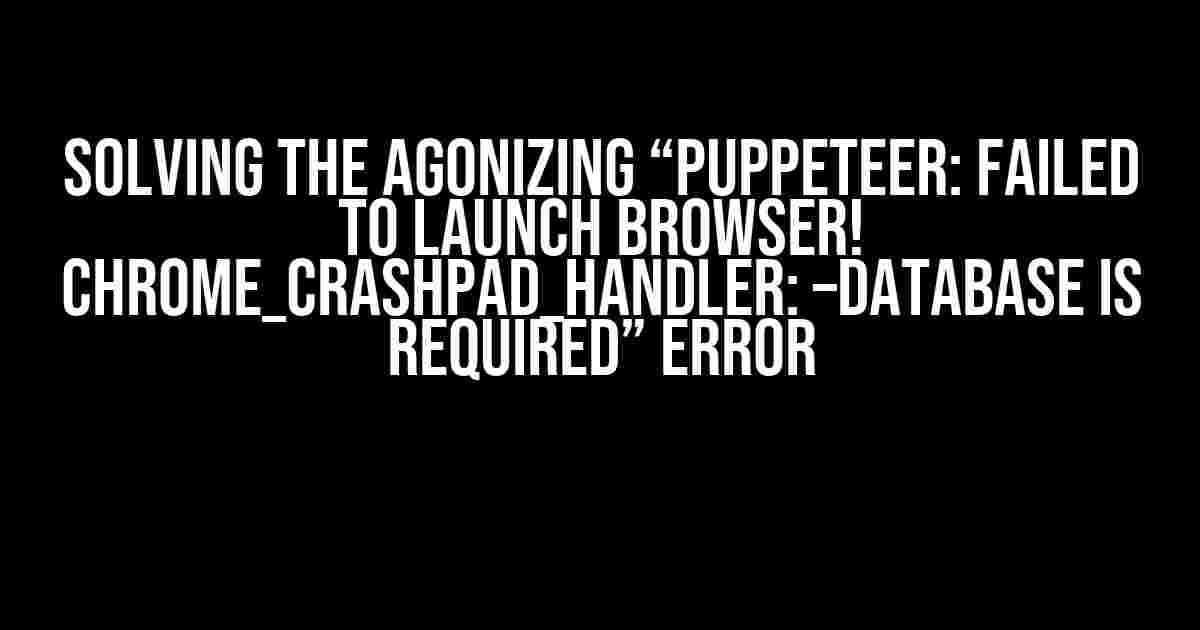If you’re reading this, chances are you’re stuck in a frustrating loop of trying to scrape the web with Puppeteer, only to be confronted with the infamous error message: “Puppeteer: Failed to launch browser! chrome_crashpad_handler: –database is required”. Fear not, dear developer, for we’re about to embark on a journey to vanquish this error and get your Puppeteer scripts up and running smoothly.
What’s the Cause of This Error?
The “chrome_crashpad_handler: –database is required” error typically occurs when Puppeteer is unable to launch a new instance of Chromium. This can happen due to various reasons, including:
- Incorrect installation of Chromium or Chrome
- Conflicting versions of Chromium or Chrome
- Corrupted browser data or cache
- Missing or incorrect configuration of the Crashpad database
In this article, we’ll delve into each of these potential causes and provide step-by-step solutions to overcome them.
Step 1: Verify Chromium Installation
First things first, let’s ensure that Chromium is installed correctly. You can do this by:
- Opening a terminal or command prompt
- Typing the command `chromium –version` (for Linux/macOS) or `chrome –version` (for Windows)
- Pressing Enter to run the command
If Chromium is installed correctly, you should see a version number printed in the terminal. If not, you can download and install the correct version of Chromium from the official website.
For Linux and macOS Users
If you’re running Linux or macOS, you can install Chromium using the following commands:
sudo apt-get update
sudo apt-get install chromium-browser
Alternatively, you can use Homebrew on macOS:
brew install chromedriver
For Windows Users
For Windows users, you can download the Chromium installer from the official website and follow the installation wizard.
Step 2: Check for Conflicting Browser Versions
Having multiple versions of Chromium or Chrome installed can cause conflicts and lead to the “chrome_crashpad_handler: –database is required” error. To resolve this, you can:
- Uninstall all versions of Chromium and Chrome
- Reinstall the correct version of Chromium (make sure it’s compatible with Puppeteer)
On Linux and macOS, you can use the following command to uninstall Chromium:
sudo apt-get purge chromium-browser
On Windows, you can uninstall Chromium through the “Add or remove programs” section in the Control Panel.
Step 3: Clear Browser Data and Cache
Corrupted browser data or cache can also contribute to the error. Let’s clear them out:
- Close all instances of Chromium and Chrome
- Delete the following directories (make sure to backup any important data before deleting):
| Operating System | Directory to Delete |
|---|---|
| Linux | ~/.config/chromium |
| macOS | ~/Library/Application Support/Chromium |
| Windows | %USERPROFILE%\AppData\Local\Chromium\User Data |
Restart your system and try running Puppeteer again.
Step 4: Configure Crashpad Database
The Crashpad database is a crucial component of Chromium’s crash reporting mechanism. To configure it:
- Create a new directory to store the Crashpad database (e.g., `~/.crashpad` on Linux/macOS or `%USERPROFILE%\Crashpad` on Windows)
- Set the `CRASHPAD_DATABASE` environment variable to point to the newly created directory:
export CRASHPAD_DATABASE=~/.crashpad
On Windows, you can set the environment variable through the System Properties:
setx CRASHPAD_DATABASE %USERPROFILE%\Crashpad
Step 5: Update Puppeteer Configuration
Finally, let’s update our Puppeteer configuration to ensure it uses the correct Chromium instance and Crashpad database:
const puppeteer = require('puppeteer');
(async () => {
const browser = await puppeteer.launch({
executablePath: '/usr/bin/chromium-browser', // Update the path to your Chromium executable
args: ['--crashpad-database-path', '~/.crashpad'], // Update the Crashpad database path
});
// Rest of your Puppeteer code
})();
Conclusion
By following these steps, you should be able to resolve the “Puppeteer: Failed to launch browser! chrome_crashpad_handler: –database is required” error and get your web scraping scripts up and running. Remember to double-check your Chromium installation, clear browser data and cache, configure the Crashpad database, and update your Puppeteer configuration.
Happy scraping!
Frequently Asked Questions
If you’ve encountered the frustrating error “Puppeteer: Failed to launch browser! chrome_crashpad_handler: –database is required” and are wondering what on earth is going on, you’re in the right place! Here are some frequently asked questions to get you back on track:
1. What does this error even mean?
Don’t worry, it’s not as cryptic as it sounds! This error occurs when Puppeteer can’t launch the Chrome browser because it needs a crashpad database to handle crashes. Think of it like a safety net for when things go wrong.
2. How do I fix this error?
Easy peasy! You can fix this by setting the `crashpadDatabase` option when launching Puppeteer. Just add the following code: `launch({ args: [`–crashpad-database-path=${tmpdir}/crashpad`], });`. This sets up a temporary crashpad database, and voilà! Your browser should launch smoothly.
3. What’s a crashpad database, anyway?
A crashpad database is a file that stores information about browser crashes. It helps Chrome debug and report issues when something goes wrong. Think of it like a digital black box that records what happened before the crash, making it easier to identify and fix problems.
4. Why does Puppeteer need a crashpad database?
Puppeteer needs a crashpad database because it’s a requirement for launching the Chrome browser in headless mode. Without it, the browser can’t start, and you’ll get the dreaded “Failed to launch browser” error. It’s a necessary evil, but don’t worry, setting it up is a breeze!
5. Will this error happen again in the future?
Hopefully not! Once you’ve set up the crashpad database, you shouldn’t encounter this error again. However, if you’re updating your Puppeteer version or making changes to your project, it’s possible that the error might resurface. But now you know the solution, so you’ll be ready to tackle it like a pro!
